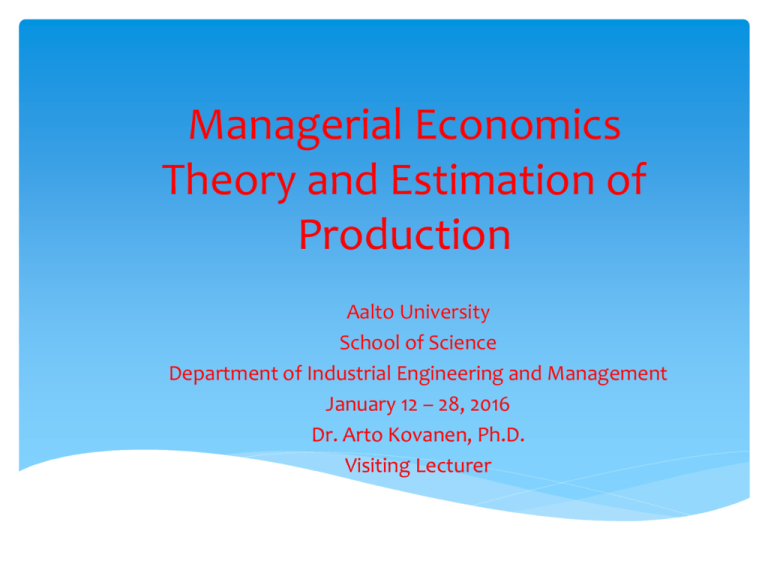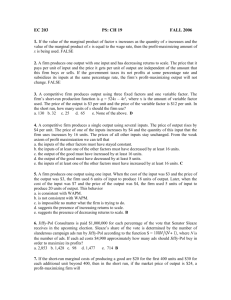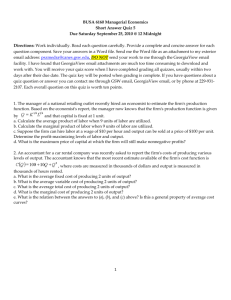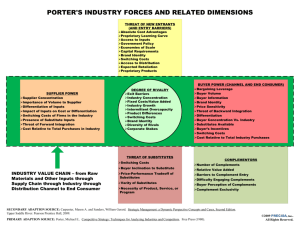Managerial Economics
advertisement

Managerial Economics Theory and Estimation of Production Aalto University School of Science Department of Industrial Engineering and Management January 12 – 28, 2016 Dr. Arto Kovanen, Ph.D. Visiting Lecturer What is a firm? Firms or businesses should be viewed as entities that transform productive resources (inputs) into outputs that can be sold – it is a process! Primary produces, manufacturing, services, trade etc. The manner in which productive resources are brought together and organized will depend on the organizing objectives and principles of the operator/management What does it require? Various types of labor, other materials, production process, decision-making … It is about profits … Mankiw, Principles of Economics What is the objective of a firm? Economists typically assume that the goal of the firm is to maximize its profits, subject to resource constraints and market information and structures The horizon is not just the current period but it includes also future periods (is it infinite?) Hence, it is assumed that the firm maximizes the present, discounted value of the stream of profits Profit maximization In this equation π = profits = total revenues – total costs while i stands for the discount interest rate Decisions on revenues and costs are often made by separate entities within the firm, such as The marketing department may be responsible for sales, which impact total revenues The production department has the responsibility for the firm’s cost of production Corporate finances are handled by another department, to support capital investments, and hence has an interest in the cost of capital (the discount rate) Coordination is important within the organization Other goals for the firm A firm typically has economic objectives such as Gaining market share Increasing return to investment Improving customer satisfaction Increasing shareholder value It may also have non-economic objectives such as Better workplace environment Improved product quality (this is related to customer satisfaction) Servicing the community (a “good citizen”) Knowing firm’s goals is critical for effective decisions Other goals for the firm (cont.) Argument: companies do not maximize profits but instead their aim is to focus on Position and power of shareholders and management Shareholders are interested in the return to investment Managers may be concerned about job security or their compensation (e.g., based on stock performance) But in the end companies must be profitable The stock price reflects company’s profitability over time If managers’ compensation is based on the stock price, then it reflects the company’s profitability Business vs. financial risk Firms face two types of risks: Business risk Financial risk Business risk involves variation in returns due to ups and downs of the economy, the industry, and the firm All firms face business risk to a varying degree Financial risk concerns variations in the returns that are induced by leverage (borrowing) The higher the degree of leverage, the greater the potential for fluctuations in the earnings Alternative measures of profits What do we mean by “profit”? Accounting profits, based on the books of the firm, may not match the meaning of the term for economists Economists’ notion of profit takes into account that any resource is scarce and has alternative uses Costs in economic terms have to do with forgoing the opportunity to produce alternative goods and services Economic costs include all relevant explicit, out-ofpocket, costs as well as implicit costs (value of inputs used in the production for which no direct payments are made) Economic vs. accounting profits Mankiw, Principles of Economics Alternative measures of profits (cont.) Example: Charles owns a small grocery store in a busy street and earns $200,000 annually. His out-of-pocket costs total $180,000, of which he pays $30,000annual salary to himself. A supermarket chain wants to hire Charles for $60,000 per year. Calculate accounting and economic profits for Charles? What is his opportunity cost of owning and managing the grocery store? Alternative measures of profits (cont.) An important concept in economics is that of normal profit, sometimes referred to as normal rate of return It is the level of profit required to keep a firm engaged in a particular activity Alternatively, it represents the rate of return on the next best alternative investment of equivalent risk Normal profit is a form of opportunity cost and hence represents a component of total economic cost Normal profit, πN , equals TC – TCO where the last term is total operating costs Alternative measures of profits (cont.) A firm breaks even in an economic sense (i.e., is earning zero economic profit) when it is earning a rate of return equal to the rate of return on best alternative That is, its operating profit, πO = TR – TCO = TR - TC – πN Furthermore, economic profit, π = πO + πN When operating profits are positive, the firm is said to be earning above-normal rate of return Example: A firm has an operating profit of $150,000. Its total revenues were $200,000 and total economic costs were $25,000. What is the company’s πN ? Firm’s production decisions How much to produce and what inputs to use? Production function and substitution between inputs is important to understand Production in the short run Total, average, and marginal product Marginal rate of technical substitution between inputs Law of diminishing returns Different stages of production Optimal use of variable inputs Production in the long run Return to scale All inputs are considered variable How do we explain production? Factors of Production Labor Capital Productivity Production function Y = A F(K,L) Physical Human Technology Institutions Production (cont.) A production function defines the relationship between inputs used in the production process and the maximum amount of output that can be generated within a given time period and with a given technology Mathematically, the production function can be expressed as Q = f(X1, X2, … …, Xk) where Q is output and Xs are inputs (e.g., labor, capital, energy, raw materials, other intermediate inputs, and so on) Production (cont.) Difference between short-run and long-run The short-run production function describes the maximum amount of output that can be produced with a given set of inputs, assuming that at least one of the inputs is fixed (e.g., machinery and buildings) The long-run production function describes the maximum amount of output that can be produced with a given set of inputs, assuming that the firm is free to adjust the level of all inputs What inputs can be adjusted in the short-run and what inputs can be adjusted only over time? Production in the short run Total product (TP) is another name for output in the short run. The total production function is the same as the short-run production function Marginal product (MP) of a variable input is the change in output (or TP) resulting from a one unit change in this input Average product (AP) of an input is the total product divided by the level of the input, which measures the level of output produced per unit of input Example: Q = f(X, Y) where X is variable input (labor) and Y is fixed input (capital). Calculate MP and AP of X. Production in the short run (example) Units of Y Employed 8 7 6 5 4 3 2 1 37 42 37 31 24 17 8 4 1 60 64 52 47 39 29 18 8 2 Output Quantity (Q) 83 96 107 117 127 78 90 101 110 119 64 73 82 90 97 58 67 75 82 89 52 60 67 73 79 41 52 58 64 69 29 39 47 52 56 14 20 27 24 21 3 4 5 6 7 Units of X Employed 128 120 104 95 85 73 52 17 8 Production in the short run Based on these data, draw TP, MP, and AP curves for a given level of the fixed input (Y) What can you say about the shape of TP, MP, and AP curves? If MP is positive, what does it mean for TP? What is the value of MP when TP is at its maximum level? What about the relationship between MP and AP? When MP > AP, is AP rising or falling? The law of diminishing returns: what it is and illustrate Production in the short run Three stages of production: Stage I: from zero units of variable input to where AP is maximized (both AP and MP rising) Stage II: from the maximum AP to where MP = 0 (AP still positive) Stage III: from where MP = 0 onwards (declining MP) Which stage should the firm operate? Why not operate in stage I where MP > 0? If the firm operates in stage II, how much it should produce? How much the firm can sell and at what price to maximize its profits (i.e., MR = MC of each input) Production in the short run (example) Labor Total Unit Product (X) (Q or TP) 0 0 1 10,000 2 25,000 3 45,000 4 60,000 5 70,000 6 75,000 7 78,000 8 80,000 Average Marginal Product Product (AP) (MP) 10,000 12,500 15,000 15,000 14,000 12,500 11,143 10,000 10,000 15,000 20,000 15,000 10,000 5,000 3,000 2,000 Total Revenue Product (TRP) 0 20,000 50,000 90,000 120,000 140,000 150,000 156,000 160,000 Marginal Revenue Product (MRP) 20,000 30,000 40,000 30,000 20,000 10,000 6,000 4,000 Total Labor Cost (TLC) 0 10,000 20,000 30,000 40,000 50,000 60,000 70,000 80,000 Marginal Labor Cost TRP(MLC) TLC 0 10,000 10,000 10,000 30,000 10,000 60,000 10,000 80,000 10,000 90,000 10,000 90,000 10,000 86,000 10,000 80,000 MRPMLC 10,000 20,000 30,000 20,000 10,000 0 -4,000 -6,000 Production in the long run In the long run all inputs can be adjusted Return to scale describes what happens to the total output when all inputs are changed by the same amount (e.g., all inputs are doubled) As a result of the return to scale, total output can be more than doubled (increasing returns to scale, IRTS), exactly doubled (constant returns to scale, CRTS), or increase less that the increase in the usage of inputs (decreasing returns to scale, DRTS) Firm’s production function can exhibit initially IRTS, then CRTS, and as output rises further, DRTS Forms of production functions The basic form is given by (for 2 inputs) Q = f(L, K) where L = labor and K = capital Substitutability between L and K Marginal return – increasing / decreasing? Some common forms: Constant Elasticity of Substitution (CES): Q = A[aL-c + (1-a)K-c]-1/c where s = elasticity of substitution = 1/(1-c) If c = 1, L and K are perfect substitutes Cobb-Douglas: lnQ = ln(A) + aln(L) + (1-a)ln(K) Forms of production functions If c approaches negative infinity, we get the Leontief production function where inputs are perfect complements (How does it look like?) Consider the following production functions: Q = 10*L – L2 +24*K – K2 Q = 10*L0.6K0.4 Q = 2*L + 4*K Calculate dQ/dL and dQ/dK, and dL/dK Calculate Q/L and Q/K Are MPL and MPK increasing or decreasing – show? What is the relationship between L and K? Given PL and PK of 5 and 15, where the firm produces? Estimating production function Data for estimating production functions come from a variety of sources Engineering data can provide answers to production questions (e.g., how much output a machine yields) Production data records the amounts of inputs (labor, capital, materials, etc.) and the resulting output that can be specific for each plan, product type and so on Using production data the management can obtain estimates showing the relationship between inputs used in production and the resulting output (using regression analysis) Provides a tangible representation of production Estimating production (cont.) The Cobb-Douglas and CES production functions used most commonly in empirical estimations (tractability) Estimation is usually done in log-linear form (parameter estimates can be viewed as elasticities) That is, Q = ALaKb can be estimated in a linear form by taking logarithms of the components: log Q = log A + a*log L + b*log K + ε Because of logarithmic transformation, the parameters a and b are now interpreted as elasticities (not slopes) We can test for a + b = 1 after running OLS Estimating production (cont.) We need to ask if the error term is uncorrelated with the variables on the right-hand side? Unknown sources of errors – no problem Observed variations in technology and the quality of inputs, left-out factors of production (e.g., materials, energy use, and land) not factored in the equation – will create problems The latter lead to biased estimates since the righthand variables are not statistically independent of the error term (some component of it) Estimating production (cont.) Is there a way to overcome these problems? E.g., output of corn, C(t), depends on area planted, K(t), and the number of sunny days, S(t) Production is given by the following linear form Ln C(t) = a*lnK(t) + (1-a)*lnS(t) If we do not have data on “sunny days”, we estimate the production function as LnC(t) = a*lnK(t) + ε(t) Estimating production (cont.) where ε(t) = (1-a)lnS(t) If the farmer does not observe S(t) before choosing K(t), then OLS would result in an unbiased estimate of “a” If production also depends on the quality of land, Q(t), which the farmer observes, but the estimation does not, leaving it out will bias the estimate of “a” That is, the quality of land affects the farmer’s decision on how large area of land he will farm Estimate factor demand function, which is a function of market-determined prices not correlated with the residual (alternative to production function) Total factor productivity The term A (or log A) in the Cobb-Douglas production function is an important parameter It is called Total Factor Productivity (TFP) It cannot be estimated directly, but instead is treated as a residual, which account for effects in total output not caused by identified inputs (often called Solomon residual) Technological improvements and efficiency are two of the biggest factors determining TFP In a regression analysis, one would estimate log Q = c + α*log L + β*log K + ε Total factor productivity (TFP) The constant term c can be interpreted as the rate of technological change Because of technological change, productivity growth can continue (e.g., return to capital has not declined in rich countries) Other factors are important: Human capital: education, training Knowledge spillovers, research and development Institutions and government (legal and political systems) Infrastructure Drives of TFP A firm can improve its TFP through a mix of: Technical change and innovation (frontier shift) • Better techniques are brought into existence, through radical innovation • Existing techniques are brought to new records of productivity • Less sophisticated techniques are discarded Catching up term (changes in the distance from the frontier) • Occurs through adaptation of well-established techniques or imitation (straightforward incorporation) • It is enough that the world frontier shifts for an immobile country to lose efficiency Production function and managerial decisions An understanding of the basic concepts of production provides a solid conceptual framework for firm’s decisions involving the allocation of firm’s resources in the short and long run A careful planning helps firms to use their resources in a rational manner Good capacity planning depends on the quality of the forecast for demand and setting production adequately Production (cont.) Managers must understand the marginal benefits and costs of each decision involving the allocation of scarce resources In real world, data on the marginal product of each input may not be available The company can evaluate trade-offs between different alternatives E.g., compare cost of installing a new voicemessaging system to the cost savings arising from the elimination of certain support personnel Pro-growth policies Policies supporting the proximate determinants R&D policies Human capital policies Policies supporting the more distant determinants At the macro level : business environment Macroeconomic framework: more stability means higher TFP Investment: Cost of capital; Savings; Infrastructure Institutions Markets: Labor, financial and international markets At the micro level: informal sector, inequality trap Growth regressions “I just ran two million regressions” (Sala-i-Martin) We can use regressions to assess impact of economic factors and government policies on growth = + 1x1 + 2x2 + … + nxn + • - vector of growth rates • x - vectors of explanatory variables This has problems of reduced form regressions— invites “data mining”








